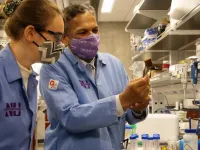(Press-News.org) PULLMAN, Wash. - No billionaires live among the Tsimane people of Bolivia, although some are a bit better off than others. These subsistence communities on the edge of the Amazon also have fewer chronic health problems linked to the kind of dramatic economic disparity found in industrialized Western societies.
For a study in the journal eLife, a research team led by Aaron Blackwell of Washington State University and Adrian Jaeggi of University of Zurich tracked 13 different health variables across 40 Tsimane communities, analyzing them against each person's wealth and the degree of inequality in each community. While some have theorized that inequality's health impacts are universal, the researchers found only two robustly associated outcomes: higher blood pressure and respiratory disease.
"The connection between inequality and health is not as straightforward as what you would see in an industrialized population. We had a lot of mixed results," said Blackwell, a WSU associate professor of anthropology. "These findings suggest that at this scale, inequality is not at the level that causes health problems. Instead maybe it's the extreme inequality in a lot of modern environments that causes health problems since it's unlike any inequality we've ever had in our evolutionary history."
Anthropologists are particularly interested in studying the Tsimane because their traditional lifestyle better resembles the conditions humans lived under for many centuries before the modern era. The Tsimane eat very little processed food--instead they forage, hunt, fish and grow crops. They also get plenty of exercise through their daily activities and have few health conditions associated with modern societies like obesity, diabetes, and heart disease. They do not have easy access to modern health care so do have to contend with parasites and many respiratory conditions ranging from the common cold to pneumonia.
Starting in 2001, a team of health care workers and researchers have visited these communities annually to provide care and collect data as part of a larger Tsimane Health and Life History Project. For this study, Blackwell, Jaeggi and their colleagues were able to analyze data from different points in time, extending to 2015.
Tsimane communities are smaller and more egalitarian than most industrialized societies but some of the communities have more inequality than others. The researchers found that for several health variables, including body mass index, gastrointestinal disorders and depression, there was not a clear connection to disparity.
However, in communities where inequality was high, many individuals had higher blood pressure, whether they were at the top or the bottom of the economic pecking order, compared to their peers in communities that were less stratified. The highest blood pressure was found among poor Tsimane men, no matter where they lived.
"Basically, it's bad to be poor, but it's also bad to be poorer," said Jaeggi. "If you feel like you're worse off than other people, that's stressful. In Western industrialized societies, it's associated with many negative health consequences like high blood pressure, cardiovascular problems and infectious disease as COVID-19 has shown. In the Tsimane communities, we did find some negative effects of living in a more unequal community, but it definitely wasn't on all of the outcomes, so it seems like it's less of a universal pattern."
This study was conducted before the pandemic, so COVID-19 impacts weren't included, but the researchers did find some connection with increased risk of respiratory disease like influenza and pneumonia to inequality. The authors said it was unclear what the exact mechanisms for that connection might be, as there wasn't a clear connection with stress, unlike in Western societies.
Blackwell also noted that while increased high blood pressure was found in more unequal communities, it hadn't developed into worse conditions such as hypertension and cardiovascular disease which are more prevalent in industrialized societies.
"I think this study tells us that there are some of the seeds of why inequality is bad for us, even in relatively egalitarian societies without huge economic differences," he said. "So perhaps if we want to increase health for everybody, then trying to reduce inequality is one route to do that."
INFORMATION:
Electrical engineers at the University of California San Diego developed a technology that improves the resolution of an ordinary light microscope so that it can be used to directly observe finer structures and details in living cells.
The technology turns a conventional light microscope into what's called a super-resolution microscope. It involves a specially engineered material that shortens the wavelength of light as it illuminates the sample--this shrunken light is what essentially enables the microscope to image in higher resolution.
"This material converts low resolution light to high resolution light," said Zhaowei Liu, a professor of electrical and computer engineering at UC San Diego. "It's very simple ...
An enhanced learning environment during the first five years of life shapes the brain in ways that are apparent four decades later, say Virginia Tech and University of Pennsylvania scientists writing in the June edition of the Journal of Cognitive Neuroscience.
The researchers used structural brain imaging to detect the developmental effects of linguistic and cognitive stimulation starting at six weeks of age in infants. The influence of an enriched environment on brain structure had formerly been demonstrated in animal studies, but this is the first experimental study to find a similar result in humans.
"Our research shows a relationship between brain structure and five years of high-quality, educational and social experiences," said Craig Ramey, ...
New research has shown that if people achieve and maintain substantial weight loss to manage their type 2 diabetes, many can also effectively control their high blood pressure and stop or cut down on their anti-hypertensive medication.
A weight management programme, developed by researchers at the Universities of Glasgow and Newcastle for the Diabetes UK-funded DIabetes REmission Clinical Trial (DIRECT), has proved effective at lowering blood pressure and reducing the need for anti-hypertensive medications, as well as bringing remission of type 2 diabetes.
The programme involves an initial 12 weeks on a nutritionally complete formula diet (low calorie soups and shakes) which will induce weight loss ...
Below please find summaries of new articles that will be published in the next issue of Annals of Internal Medicine. The summaries are not intended to substitute for the full articles as a source of information. This information is under strict embargo and by taking it into possession, media representatives are committing to the terms of the embargo not only on their own behalf, but also on behalf of the organization they represent.
1. Tai chi about equal to conventional exercise for reducing belly fat in middle-aged and older adults
HD video soundbites ...
UCLA HEALTH RESEARCH BRIEF
FINDINGS
A new study shows that tai chi mirrors the beneficial effects of conventional exercise by reducing waist circumference in middle-aged and older adults with central obesity. The study was done by investigators at the University of Hong Kong, The Chinese University of Hong Kong; Chinese Academy of Sciences; and UCLA.
BACKGROUND
Central obesity is a major manifestation of metabolic syndrome, broadly defined as a cluster of cardiometabolic risk factors, including central obesity, dyslipidemia, hyperglycemia, low high-density lipoprotein ...
A new study published in Proceedings of National Academics of Sciences finds that individuals who falsely believe they are able to identify false news are more likely to fall victim to it. In the article published today, Ben Lyons, assistant professor of communication at the University of Utah, and his colleagues examine the concern about the public's susceptibility to false news due to their inability to recognize their own limitations in identifying such information.
"Though Americans believe confusion caused by false news is extensive, relatively few indicate having seen or shared it," said Lyons. "If people incorrectly see themselves as highly skilled at identifying false news, they may unwittingly be more likely to consume, believe and share it, especially if it conforms to their ...
Phosphate pollution in rivers, lakes and other waterways has reached dangerous levels, causing algae blooms that starve fish and aquatic plants of oxygen. Meanwhile, farmers worldwide are coming to terms with a dwindling reserve of phosphate fertilizers that feed half the world's food supply.
Inspired by Chicago's many nearby bodies of water, a Northwestern University-led team has developed a way to repeatedly remove and reuse phosphate from polluted waters. The researchers liken the development to a "Swiss Army knife" for pollution remediation as they tailor their membrane to absorb ...
Very high atmospheric CO2 levels can explain the high temperatures on the still young Earth three to four billion years ago. At the time, our Sun shone with only 70 to 80 per cent of its present intensity. Nevertheless, the climate on the young Earth was apparently quite warm because there was hardly any glacial ice. This phenomenon is known as the 'paradox of the young weak Sun.' Without an effective greenhouse gas, the young Earth would have frozen into a lump of ice. Whether CO2, methane, or an entirely different greenhouse gas heated up planet Earth is a matter of debate among scientists. New research by Dr ...
Art Garfunkel once described his legendary musical chemistry with Paul Simon, "We meet somewhere in the air through the vocal cords ... ." But a new study of duetting songbirds from Ecuador, the plain-tail wren (Pheugopedius euophrys), has offered another tune explaining the mysterious connection between successful performing duos.
It's a link of their minds, and it happens, in fact, as each singer mutes the brain of the other as they coordinate their duets.
In a study published May 31 in Proceedings of the National Academy of Sciences, a team of researchers studying brain ...
Three groups (Dr. James Birchler's group from University of Missouri, Dr. Jan Barto's group from Institute of Experimental Botany of the Czech Academy of Sciences and Dr. HAN Fangpu's group from the Institute of Genetics and Developmental Biology of the Chinese Academy of Sciences) recently reported a reference sequence for the supernumerary B chromosome in maize in a study published online in PNAS (doi:10.1073/pnas.2104254118).
Supernumerary B chromosomes persist in thousands of plant and animal genomes despite being nonessential. They are maintained in populations by mechanisms of "drive" that make them inherited at higher than typical Mendelian rates. Key properties such as its origin, evolution, and the molecular mechanism for its accumulation in ...



